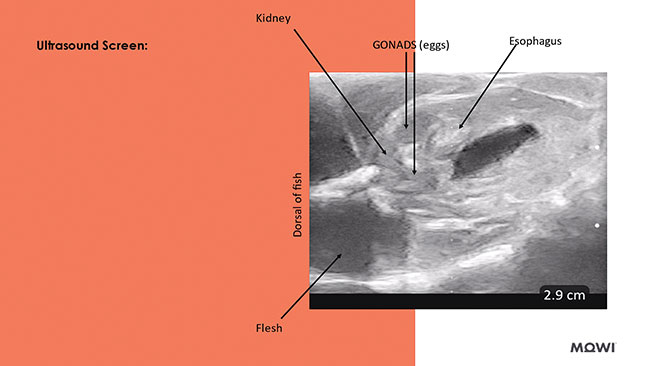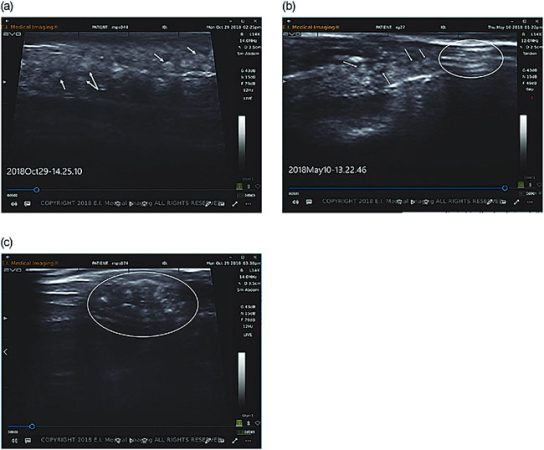
Features
Breeding
Ultrasound techniques and technology for salmonid culture
May 11, 2022 By Ron Hill
 An ultrasound of a dorsal fin of a fish. (Image: Mowi)
An ultrasound of a dorsal fin of a fish. (Image: Mowi) The use of ultrasound imaging technology to examine the inside of fish has been available for many years.
Sturgeon producers in particular embraced the technology to help with the tricky job of sexing sturgeon.
Useful as the technology is, many farms are reluctant to embrace an expensive unit and do not see the value or how it will improve their bottom line. Despite there being well-mapped techniques and notable benefits for salmonid farms, ultrasounds are used most by large corporations with large brood programs or research institutions.
Though ultrasound units are not for every salmonid farm, any farm holding brood and producing eggs should consider what an ultrasound can do to up their bottom line and smooth their egg production. Ultrasound units do have a few uses other than sexing and breeding but nothing as impactful.
What an Ultrasound Can Do for a Breeding Program
An ultrasound unit can improve a breeding program in three particularly effective ways:
1. Determining fish sex
First and foremost, an ultrasound unit will let the operator see the eggs within a salmonid. Broodstock Technical Manager Trevor Dawes, who oversees the ultrasound operation at Mowi Canada West, explains, “Sex determination is a simple presence or absence equation, eggs are present- the fish is female, no eggs present- the fish is male.”
Dawes continues, “sexing allows the farmer to create brood groups that maximize the number of females by retaining the minimum number of males, thereby maximizing both space usage and the total eggs the facility can produce. Since Males can be spawned multiple times, only about 20 per cent of our Atlantic salmon brood group need be male.”
Atlantic salmon can be sexed as small as 80 grams. The earlier sexing can be achieved, and males removed the better. By removing extra males early in the production cycle, the expense of feeding and keeping these fish is also removed. Without sexing, a farmer must wait until the onset of maturing and secondary sexual characteristic to sex a salmonid.
If a group of 1000 unsexed fish were held as brood, it is anticipated there would be (approximately) 50 per cent males and 50 per cent females, therefore about 500 of each fish. A brood program only needing 20 per cent of the fish be males, which is 300 extra fish with no value, which have been held for three to four years. By removing those 300 males and replacing them with 300 extra females producing eggs, the value of sexing becomes obvious.
2. Determining spawning time
By using the scanner to measure the length of the gonad, farmers can see how well fish are developing within their brood groups and further group them into early, middle, and late spawners.
Dawes elaborates, “by the time our Atlantic salmon are 3-4.5 kilograms, spawning time can be reasonably determined. Gonad size gives a good relative approximation of development, allowing farmers to sort their brood into subgroups based on the gonad size. Fish found that are severely behind in development, or contain eggs that look damaged/unviable, can be removed from the spawning group as well. These subgroups (early, middle, late) can be subsequently manipulated to control spawning time using lights.”
This control and predictability are a great benefit that allows farms to plan their production with less uncertainty in their schedule and spawn timing, and plan when eggs will be available.
3. Pre-spawning health and viability checks
By scanning the females five months before spawning, egg viability can be determined, and non-viable females can be removed.
“The ultrasound image will show water in the eggs, seen as black rims around the eggs, indicating the fish is reabsorbing their eggs and isn’t viable for breeding. You can also assess the heart and other organs at the same time,” suggested Dawes.

Ultrasound images of a mature female Cutthroat Trout. Eggs appear as soft, round orbs and fill the abdominal cavity. Arrows point to several of many eggs. images: Kellie J. Carim et al., PLOS One
Scanning and Seeing
The scanners are user-friendly for a piece of sophisticated technology. The ultrasound scanners are ergonomic and easy to operate. The units are handheld and paired to a smart device that displays the imaging. When the scanner is placed along the side of the fish, it shows an ultrasound image of the internals.
Using the scanner is easy but interpreting the scanner is where the skill and experience of an operator becomes a factor. The operator interprets the image to determine presence of absence of eggs. As the scanner is slid toward the posterior of the fish, the operator notes if eggs are present and where the eggs start and stop to get a gonad length. The unit is held on the left side of the fish, 95 per cent of the time in Atlantic salmon the left is the bigger gonad so for the sake of consistency this is the standard practice.
The scanner is placed on the side of the fish, but the image is not a side view. The scanner reveals a cross section of the fish. It is like you cut through the fish and are looking down it from head to tail.
“Image interpreting takes some time to learn what you are seeing and the subtleties in the differences. After a technician has experience, the scanning and interpreting process takes only five seconds per fish. Being able to see and identify the eggs is the largest focus and is the easiest to pickup, but to notice the black rims of water filled or dying eggs takes an experienced eye. An experienced operator an easily achieve 95 per cent accuracy sexing,” Dawes explained.
Setting it Right
Getting the scanner set right a huge factor with ultrasound units. Scanners can show eggs in fish under 100 grams but the depth penetration of the unit must be set properly for the size of the fish. How the unit is held determines the quality of the imaging.
“We often are using our units in saltwater. The units are waterproof, but we usually stick them inside a Ziploc bag to keep the saltwater off them. It also is a good biosecurity measure. The cord for the scanner is run up through the jacket of the operator and scanner hangs on the wrist. “
Because of its nonobtrusive nature, it is easy to combine ultrasound scanning with other tasks where a fish is being handled. When fish are being moved or split, a subset can be checked quickly with the scanner to monitor development in the group.
Adopting Ultrasound
Atlantic salmon farmers like Mowi are well funded and have large brood programs, so the CA$8,000 to $12,000 (about US$6,300 to $9,500) price tag is not prohibitive, and the unit will see full time use. Small and midsized farmers can be dissuaded by the price, but ultrasound technology can make a beneficial fiscal impact, especially in the long term. It is adaptable for other salmonid species; the techniques are well mapped, if not widely distributed, and should be considered by any farm holding their own salmonid brood.
Print this page
Advertisement
- BactiQuant anti-fungal solution for RAS
- Japanese research uses green light to grow flatfish 60% faster





